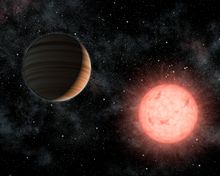Red dwarf
A red dwarf is a kind of star. Red dwarf stars are smaller than half the size of the Sun. They are also cooler than most stars. Red dwarfs burn their fuel slowly, so they shine with less light (absolute magnitude) than hot stars.

Red dwarf stars are the most common in our galaxy, at least near our sun. (We cannot see them if they are in other distant galaxies.) However, since red dwarf stars are cool and small, none can be found with the naked eye. The closest star to the Earth is named Proxima Centauri. The Latin word proxima means "nearest to". Proxima Centauri is a red dwarf.
Life and death
changeRed dwarfs can live trillions of years, much longer than brighter stars. A red dwarf dies when it burns all of its fuel. To start with, the fuel is the chemical element hydrogen. At present, no red dwarf star is known which has gone beyond this stage, because the universe is only 14 billion years old..[1]
Red dwarfs are small stars that are around 0.2 solar mass (the sun is equal to 1 solar mass). This is small for a star but is still 60,000 times the mass of the Earth. They are formed in nebulas, as all stars are, and originally they were protostars. They start their nuclear fusion about 100,000 years after being formed. This gives them their red glow. These stars burn at less than 4,000°K.
Ultracool dwarfs are the smallest type of red dwarf. Below is a list of the smallest red dwarfs.[2]
| Name | Radius (Solar radii) | Notes |
|---|---|---|
| CWISE J124909.08+362116.0 | 0.08 | Possibly a brown dwarf. |
| SSSPM J2356-3426 | 0.0835 | Possibly 0.094 solar radii. |
| EBLM J0555-57 Ab | 0.084 | Most likely the smallest red dwarf. |
| 2MASS J0523-1403 | 0.086 | Possibly a brown dwarf. |
| SSSPM J0829-1309 | 0.088 | Possibly a brown dwarf. |
| RG 0050-2722 | 0.091 | |
| SCR 1845-6357 | 0.0941 | Has a brown dwarf companion. |
| HD 114762 B | 0.1 | |
| LHS 2924 | 0.103 | |
| DENIS J1048-3956 | 0.108 | |
| 2MASS J04285096-2253227 | 0.1095 | At 80 Jupiter masses and is borderline brown dwarf. |
| 2MASSI J2356547-155310 | 0.1095 | At 80 Jupiter masses and is borderline brown dwarf. |
Even smaller stars are called brown dwarfs.
References
change- ↑ Richmond, Michael (2004). "Late stages of evolution for low-mass stars". Rochester Institute of Technology. Retrieved 2007-09-19.
- ↑ Staff, News (2024-06-12). "Citizen Scientists Discover Hypervelocity L-Subdwarf Star in Solar Neighborhood | Sci.News". Sci.News: Breaking Science News. Retrieved 2024-07-15.
{{cite web}}:|first=has generic name (help)